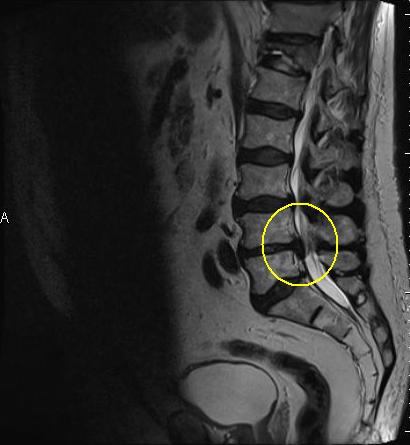The herniated disc is a disease of the spine, to step forward in the parts of the intervertebral disc into the spinal canal - the space in which lies the spinal cord -. In contrast to the disc protrusion (bulging) is the prolapse of the fibrous cartilage ring of the intervertebral disc (annulus fibrosus) ruptured in whole or in part) while the posterior longitudinal ligament is intact (so-called subligamentärer herniated disc.
Previous accidents is often an overload in the intervertebral discs, a herniated disc can also occur without any external cause. Symptoms of herniated disc are strong, often radiating pain in the extremities, often with a numbness in the distribution of the trapped nerve root, and sometimes paralysis. Treatment is conservative in most cases possible serious incidents must be treated surgically.
 The prolapsed intervertebral disc tissue, almost always shares of fibrocartilage rings around the
The prolapsed intervertebral disc tissue, almost always shares of fibrocartilage rings around theso-called nucleus are arranged concentrically around, pushes the contents of the spinal canal and / or nerve root. Spinal cord, dorsal root, spinal nerve, intervertebral disc, fibrous ring, Degenerate nucleus, in between the cartilage ring, 8 vertebral Discs are bradytrophic tissue, which means they are not powered directly from the bloodstream out of nutrients, but by diffusion. This play semi-permeable membranes, which separate the cartilaginous rings, the decisive role. By shear forces can tear the membranes, making them lose their function and dries out the disc along with the intervertebral disc nucleus pulposus (nucleus pulposus). When it comes to a herniated disc, the nucleus is practically no longer exist in its original form. The herniated disc thus arises mostly at the bottom of a long predamages the intervertebral disc. The nucleus (about 80% water) in the healthy intervertebral disc consists of a jelly-like, cell-poor tissue, including without limitation during exercise, together with the cartilaginous rings and the membranes of the function of a hydraulic ball (water cushion). The vertebral bodies and intervertebral disks allow the front with the rear facet joints (facet joints), the high mobility of the entire spine, but also its high stability

